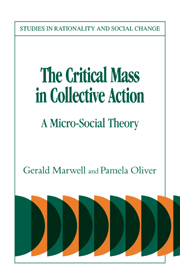Book contents
- Frontmatter
- Contents
- PREFACE
- ACKNOWLEDGMENTS
- 1 The critical mass and the problem of collective action
- 2 Building blocks: goods, groups, and processes
- 3 The paradox of group size
- 4 The dynamics of production functions
- 5 Social networks: density, centralization, and cliques
- 6 Selectivity in social networks
- 7 Reach and selectivity as strategies of recruitment
- 8 Unfinished business
- REFERENCES
- NAME INDEX
- SUBJECT INDEX
2 - Building blocks: goods, groups, and processes
Published online by Cambridge University Press: 19 March 2010
- Frontmatter
- Contents
- PREFACE
- ACKNOWLEDGMENTS
- 1 The critical mass and the problem of collective action
- 2 Building blocks: goods, groups, and processes
- 3 The paradox of group size
- 4 The dynamics of production functions
- 5 Social networks: density, centralization, and cliques
- 6 Selectivity in social networks
- 7 Reach and selectivity as strategies of recruitment
- 8 Unfinished business
- REFERENCES
- NAME INDEX
- SUBJECT INDEX
Summary
In this chapter we describe the “building blocks” of our analytic strategy – the major concepts and simplifying assumptions that we use for modeling collective action – and discuss many of the scope conditions that circumscribe the applicability of the models. The real world of collective action is obviously much too complex to be captured by any single theoretical model. Real events are always the result of the conjunction of many processes and accidental occurrences. We make drastic simplifying assumptions in our models not because we believe they are “true,” but as a way of isolating a tractable part of a complex phenomenon.
It will be helpful to ground our often technical discussion in an example (used throughout the book) drawn from our experience with voluntary action and social protest. Imagine that there are several cities that have just passed identical ordinances requiring their employees to be city residents, effective next year. (Such ordinances are, in fact, quite common.) Each of the cities currently employs some workers who will be directly affected. None of these ordinances now exempts current employees from the requirement, but an amendment providing such an exemption (a “grandfather clause”) is possible.
In Olson's terms, the grandfather clause amendment is a clear example of a collective good for suburban-dwelling city employees: all such employees will benefit from the amendment, whether or not they help to get it passed. However, a simplistic “Olson model” would predict that every rational employee will try to free-ride (assuming a large group), that no collective action will take place, and that the amendment will not be passed.
- Type
- Chapter
- Information
- The Critical Mass in Collective Action , pp. 14 - 37Publisher: Cambridge University PressPrint publication year: 1993



